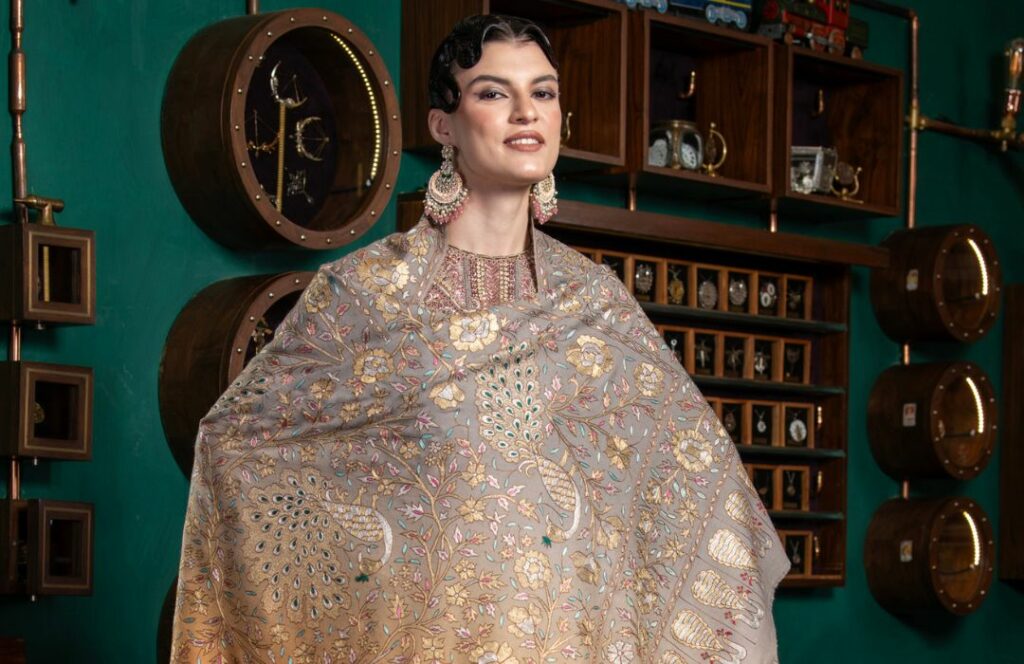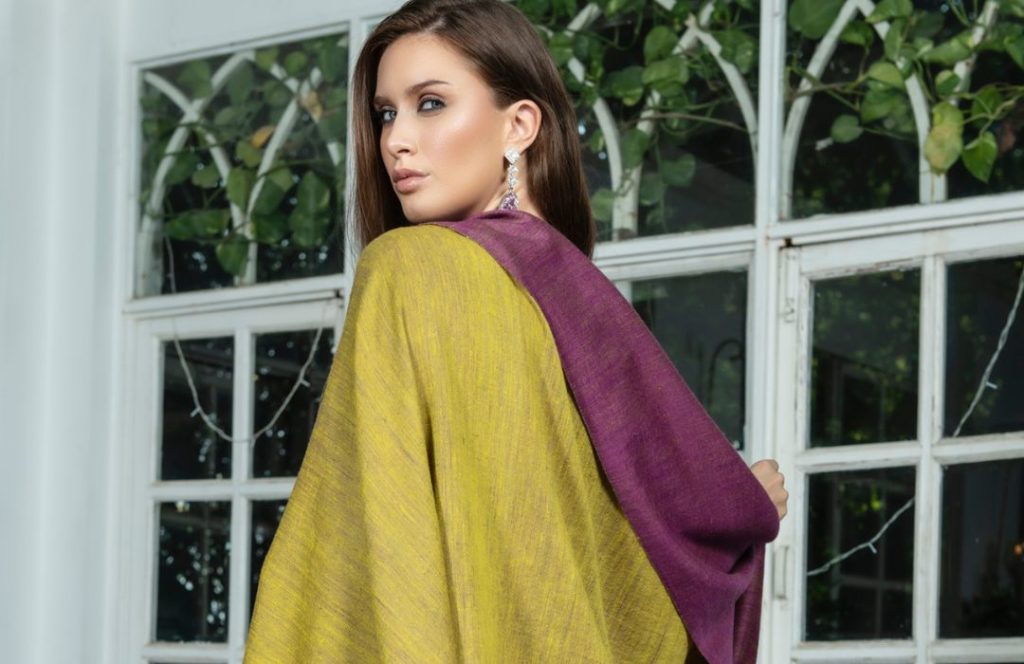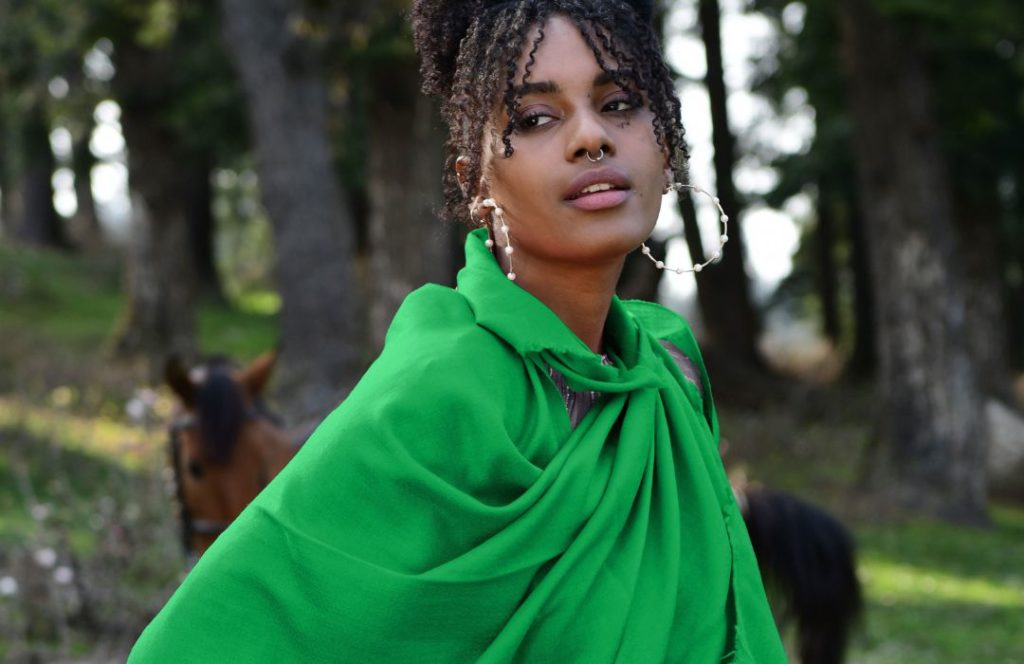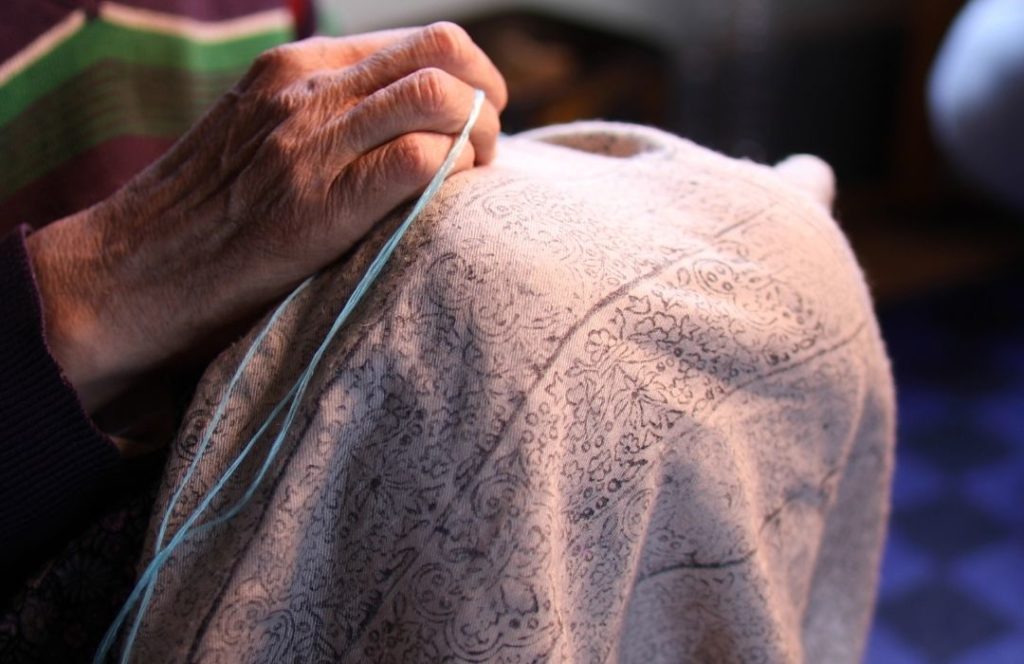Originating from the Himalayan region, the Pashmina shawl has a history as rich and intricate as its intricate weaves. Its cultural significance stretches across borders, making it a symbol of heritage, craftsmanship, and refinement. As we delve into the etiquette of wearing Pashmina shawls, it becomes evident that these are more than just accessories. Thus, these are a nod to tradition, an acknowledgment of craftsmanship, and an expression of personal style.
Beyond the realms of fashion, Pashmina shawl has played a central role in various cultural ceremonies and celebrations. From weddings to religious rituals, the Pashmina shawl has adorned shoulders and certainly become a part of important cultural narratives. Thus, understanding the cultural significance adds depth to the act of wearing a Pashmina, transforming it into a mindful and respectful gesture.
In this exploration of Pashmina etiquette, we uncover the nuances that elevate the experience of donning this luxurious accessory. Whether wrapped around shoulders during a chilly evening or elegantly draped over an ensemble at a formal gathering, wearing a Pashmina is a deliberate act. It reflects an appreciation for heritage and a commitment to timeless elegance. Thus, join us on this journey into the world of Pashmina etiquette. Therefore, each fold, each drape, carries not just fabric but a story of tradition, culture, and enduring style.
Origins and Cultural Significance of a Pashmina shawl

The journey of the Pashmina shawl begins high in the majestic Himalayan region. Here, the harsh climates and rugged terrains are home to a unique breed of goats. These are called Changthangi or Pashmina goats. Adapted to the extreme cold, the goats boast an incredibly soft and fine undercoat, which becomes the coveted Cashmere fiber. Thus, the region's artisans, with their age-old craftsmanship, transform this fine fiber into the exquisite Pashmina shawls we admire today.
Intricately woven into the cultural tapestry of the Himalayan communities, Pashmina holds a special place in the hearts locals. Its origins go back centuries, and its journey is intertwined with the rich history of the region. Thus, Pashmina shawls have adorned the shoulders of royalty. Also, these have been featured in the attire of monks and religious figures, signifying purity and divinity.
Beyond its geographical roots, Pashmina has transcended borders and cultures. The allure of its softness and the artistry of its craftsmanship have made it a symbol of luxury worldwide. Thus, from the regal courts of ancient Persia to the contemporary runways of Paris, the Pashmina shawl has retained its timeless appeal. Hence, it has become an accessory that traverses both time and cultural boundaries.
The cultural significance of Pashmina extends to various ceremonies and celebrations. In Kashmir, people consider the Pashmina shawl an integral part of a bride's trousseau, symbolizing purity, warmth, and prosperity. Thus, it is not merely an accessory but a cherished heirloom passed down through generations, carrying with it the blessings and traditions of the family.
As we delve into the etiquette of wearing a Pashmina, let us keep in mind its origins. Let's remember the snowy peaks, the nomadic herders, and the age-old looms that have woven a fabric of cultural significance and unparalleled beauty.
Selecting the Right Pashmina Shawl

When venturing into the world of Pashmina, the first step is selecting the right one—an art in itself that involves an understanding of the intricate details that make each piece unique.
Quality is Paramount
The hallmark of an exceptional Pashmina lies in its quality. Authentic Pashmina shawl, crafted from the fine undercoat of Pashmina goats, is famous for its unparalleled softness and warmth. Thus, ensure the utmost quality, opt for Pashminas made with pure Cashmere, as this guarantees a luxurious feel against the skin.
Material Matters
Apart from Cashmere wool, various blends are available, combining silk or other fibers. While these blends may offer different textures and finishes, purists prefer 100% Cashmere for its unique characteristics. Silk blends can add a glossy sheen and durability, creating a fabric that is both luxurious and resilient. But pure Pashmina certainly has no match.
Craftsmanship of Pashmina Shawl
The craftsmanship of a Pashmina is indeed a testament to the skill of the artisans who weave these exquisite pieces. Handwoven Pashmina shawls carry an inherent charm, showcasing the artistry and dedication of the craftspeople. So, one should look for subtle imperfections, which often indicate handcrafted authenticity.
Authentication of Pashmina Shawl is Key
In a market flooded with imitations, authenticating your Pashmina is crucial. Organisations label genuine Pashminas with a certification mark or tag indicating their authenticity. Kashmir, the heartland of Pashmina production, has its own certification mark to identify products that meet specific standards. When purchasing, inquire about these markers and, if possible, buy from reputable sources or directly from artisans.
Feel and Texture of Pashmina Shawl
Run your fingers across the fabric to gauge its softness. Authentic Pashmina should feel incredibly soft and lightweight. The texture should be smooth, and the fabric should drape elegantly, thus allowing for versatile styling.
Choosing the right Pashmina is akin to selecting a piece of wearable art. It involves appreciating the nuances of craftsmanship, understanding the blend of materials, and ensuring the piece's authenticity. A carefully chosen Pashmina not only enhances your attire but also becomes a cherished possession, embodying the rich heritage and artistry of this timeless accessory.
Occasions and Appropriateness through Pashmina Shawl
The beauty of a Pashmina shawl lies not only in its luxurious feel but also in its versatility, making it suitable for a myriad of occasions. Understanding the etiquette of when and where to wear a Pashmina adds an extra layer of sophistication to your ensemble.
Formal Affairs

For formal events like weddings, galas, or upscale dinners, a Pashmina can be the epitome of refinement. Opt for solid, classic colours or subtle patterns that complement your outfit without overshadowing it. Draping the Pashmina over your shoulders or elegantly wrapping it around your arms adds a touch of glamour without compromising on the formality of the occasion.
Casual Outings
Pashminas aren't reserved solely for formal events; they seamlessly transition into casual outings. Whether you're meeting friends for coffee, strolling through a park, or enjoying a relaxed dinner, a Pashmina can elevate your casual attire. Choose vibrant colors or playful patterns to inject a hint of personality into your look. Opt for loose wraps or creative knots for a laid-back yet stylish vibe.
Cultural Celebrations
Pashminas have deep cultural roots, especially in regions like Kashmir. During cultural celebrations, ceremonies, or festivals, wearing a Pashmina can be a respectful nod to tradition. Consider Pashminas with intricate embroideries or traditional patterns that celebrate the rich heritage of the garment. How you drape it may also carry cultural significance, so take cues from the local customs.
Seasonal Appropriateness
The choice of a Pashmina shawl can also be influenced by the seasons. In colder months, thicker and warmer Pashminas provide both style and comfort. During warmer seasons, opt for lightweight Pashminas that add a touch of elegance without causing discomfort.
Remember, the key lies in striking a balance. Your Pashmina should complement the occasion rather than overshadow it. By understanding the appropriateness of wearing a Pashmina across various settings, you not only showcase your sartorial savvy but also pay homage to the cultural and historical significance woven into this timeless accessory.
Draping Styles and Techniques of Pashmina Shawls
Draping a Pashmina is an art form, and mastering various styles allows you to express your individuality while embracing the elegance of this exquisite accessory. Here's a comprehensive guide with step-by-step instructions and visuals to help you navigate the world of Pashmina draping.
Classic Shoulder Drape:
Begin by folding the Pashmina shawl in half to create a triangle. Drape it over your shoulders with the pointed end hanging down your back. Secure it by crossing the ends at the front and tossing them over each shoulder.
Front Knot Wrap:
Start with the Pashmina shawl around your neck, leaving one end longer than the other. Tie a loose knot with the longer end, allowing the ends to cascade down.
Pashmina Shawl Style:
Open up the Pashmina to its full width. Drape it over your shoulders, letting it fall freely. For a more formal look, secure it with a brooch at one shoulder.
Belted Shawl Wrap:
Drape the Pashmina over your shoulders as a shawl. Secure it with a stylish belt at the waist, creating a cinched, polished look.
Turban Style:
Fold the Pashmina into a thin, long strip. Wrap it around your head, creating a turban-like effect.
Pinned Elegance:
Choose a decorative pin or brooch. Secure the Pashmina at one shoulder, creating an asymmetrical draped effect.
Experiment with these styles to find what suits your outfit and the occasion best. The beauty of Pashmina lies not just in its fabric but in the myriad ways you can adorn yourself with it, turning every outing into a canvas for your personal style.
Colour Coordination in Pashmina Shawls

Wearing a Pashmina isn't just about its luxurious fabric; it's also a canvas for showcasing your impeccable sense of style. One of the key elements to master in the etiquette of Pashmina wearing is colour coordination. The right colour pairing can elevate your entire ensemble, making a lasting impression. Here's a guide on how to harmonize the hues of your Pashmina with your outfit.
Monochromatic Magic:
Choose a Pashmina that shares the same colour family as your outfit.
This creates a seamless, sophisticated look, allowing the texture of the Pashmina to take center stage.
Tip: A deep red Pashmina over a burgundy dress exudes timeless elegance.
Contrasting Brilliance:
Opt for a Pashmina in a contrasting colour to add a pop of excitement.
For instance, a royal blue Pashmina can complement a white or neutral-toned outfit, creating a striking visual contrast.
Tip: Experiment with bold colors to create a dynamic and eye-catching effect.
Neutral Elegance:
When in doubt, go for a neutral Pashmina.
Neutral tones like beige, ivory, or gray can effortlessly complement a wide range of outfits, making them versatile choices for various occasions.
Tip: A neutral Pashmina is a wardrobe staple for its adaptability.
Printed Patterns:
If your outfit is plain, consider a Pashmina shawl with subtle patterns or prints.
Ensure the patterns don't clash with your attire, adding a touch of visual interest without overwhelming the look.
Tip: A floral-patterned Pashmina can bring a touch of femininity to a solid-coloured dress.
Seasonal Harmony:
Consider the season when choosing Pashmina colours.
Lighter shades for spring and summer, deeper tones for fall, and richer, darker colors for winter can align your look with the seasonal vibe.Tip: A pastel Pashmina in spring adds a delightful touch to your ensemble.
Remember, the goal is to create a harmonious and balanced look. Experiment with different colour combinations to discover what resonates with your personal style. Whether you're attending a formal event or a casual outing, mastering the art of color coordination will set you apart as a Pashmina aficionado with an eye for elegance
Pashmina shawl and seasonal adaptations
As the seasons change, so does the way we dress, and your Pashmina should seamlessly transition to complement the weather. Understanding how to adapt this luxurious accessory to different seasons ensures you stay both stylish and comfortable throughout the year.
Spring Fling:
Opt for lightweight Pashminas in pastel shades during spring.
Delicate weaves and breathable fabrics will add a touch of elegance without overheating.
Tip: A light floral Pashmina draped casually over your shoulders is the perfect springtime accent.
Summer Breeze:
Choose sheer or silk-blend Pashminas for summer outings.
These options provide a hint of luxury without being too warm, making them suitable for outdoor events.
Tip: A white silk Pashmina paired with a sundress is the epitome of summer chic.
Autumn Warmth:
Transition to richer and warmer tones as the weather cools down.
Consider medium-weight Pashminas with intricate weaves to provide both style and warmth.
Tip: A caramel-colored Pashmina draped over your shoulders adds a cozy touch to your fall wardrobe.
Winter Wonderland:
Embrace thicker and cozier Pashminas made from pure wool or blended fabrics.
Look for bold colours and intricate patterns to make a statement while staying warm.
Tip: A deep burgundy or forest green Pashmina is perfect for winter evenings.
Versatile Neutrals:
Invest in neutral-coloured Pashminas that can be worn year-round.
These timeless pieces add sophistication and can be easily paired with a variety of outfits.
Tip: A classic beige Pashmina is a versatile accessory suitable for any season.
Remember, adapting your Pashmina to the season isn't just about staying weather-appropriate; it's about enhancing your overall look. Whether you're attending a summer wedding or a winter gala, let your choice of Pashmina reflect the beauty of the season and complement the occasion with grace and style.
Pashmina Shawl and Cultural Sensitivity

Wearing a Pashmina isn't just about fashion; it's also about respecting cultural traditions and heritage. Thus, understanding the cultural sensitivity associated with Pashmina ensures that you wear it with reverence and appreciation for its origins and significance.
Himalayan Heritage:
The Pashmina has deep roots in the Himalayan region, where it's been woven for centuries.
Recognize and honor the craftsmanship and artistry of the artisans who create these exquisite pieces.
Symbolism and Tradition:
In many cultures, the Pashmina holds symbolic meaning beyond its aesthetic appeal.
It may be worn during special ceremonies, celebrations, or religious rituals, signifying warmth, protection, and blessings.
Cultural Appropriation Awareness:
Be mindful of cultural appropriation when wearing Pashmina, especially if you're not part of the communities where it holds significant cultural value.
Avoid treating Pashmina as a mere trend or accessory without understanding its cultural context.
Respectful Styling in Pashmina Shawls :
When incorporating Pashmina into your outfit, do so with respect and modesty.
Avoid appropriating traditional styles or sacred motifs without understanding their cultural significance.
Supporting Artisan Communities through Pashmina Shawls :
Choose Pashmina products that support ethical sourcing and fair trade practices.
By purchasing from reputable sellers who value and support artisan communities, you contribute to the preservation of traditional craftsmanship.
Cultural Significance of Pashmina Shawls
Take the time to learn about the cultural significance of Pashmina in different regions and communities.
Educating yourself fosters cultural awareness and appreciation, allowing you to wear Pashmina with greater respect and understanding.
Cultural Sensitivity through Pashmina Shawl in Fashion:
Fashion should celebrate diversity and cultural heritage rather than appropriating it for commercial gain.
Be an advocate for cultural sensitivity in fashion by promoting ethical practices and respectful representation.
By embracing the cultural significance of Pashmina and wearing it with mindfulness and respect, you not only honor its heritage but also contribute to a more inclusive and culturally aware fashion landscape. Let your appreciation for Pashmina extend beyond its beauty, recognizing the rich tapestry of traditions and stories woven into every thread.
Caring for Pashmina Shawls

The delicate beauty of a Pashmina shawl deserves careful attention and thoughtful care to ensure it remains a timeless accessory in your wardrobe. Follow these practical tips to preserve the elegance of your Pashmina and extend its longevity:
Cleaning Techniques:
Gentle Handwashing: Opt for handwashing over machine washing to maintain the softness of Pashmina. Use detergent in lukewarm water.
Avoid Harsh Chemicals: Refrain from using harsh chemicals or bleach, as they can damage the delicate fibers of the Pashmina.
Drying with Care:
Flat Drying: Lay your Pashmina flat on a clean, dry towel to air dry. Avoid hanging it, as the weight of the water can distort the shape.
Shape Preservation: Gently reshape the Pashmina while damp to retain its original form. Keep it away from direct sunlight to prevent fading.
Storage Wisdom:
Fold, Don't Hang: Folding is the preferred method for storing Pashmina. Hanging can cause the fabric to stretch over time.
Use Breathable Storage: Store your Pashmina in a breathable cotton or muslin bag to protect it from dust. Avoid plastic, as it can trap moisture.
Beware of Snags:
Keep Away from Jewelry: Be cautious with jewelry and accessories that may snag the delicate fibers. Therefore, store your Pashmina separately to prevent accidental pulls.
Occasional Airing:
Air It Out: Even if you haven't worn your Pashmina, give it some fresh air occasionally. This prevents any musty odors from developing during storage.
Handle with Clean Hands:
Clean Hands Rule: Ensure your hands are clean before handling your Pashmina. Oils and dirt from your hands can transfer to the fabric.
Pilling Prevention:
Gently Remove Pills: Use a fabric shaver or a soft brush to remove any pills that may form on the surface. Additionally, be gentle to avoid damaging the fibers.
Professional Cleaning of Pashmina Shawls :
Seek Professional Care: If your Pashmina requires deep cleaning, consider professional dry cleaning services. Also, ensure the cleaner is experienced with delicate fabrics.
By adopting these care practices, you not only protect the exquisite nature of your Pashmina but also contribute to its endurance as a cherished accessory. In addition, treat your Pashmina with the care it deserves, and it will continue to grace your wardrobe with its timeless elegance for years to come.
Also read: Pashmina in the Hymns of a Kashmiri wedding
Pashmina shawls beyond fashion
In conclusion, the art of wearing a Pashmina extends beyond mere fashion; it is a cultural journey, a nod to history, and a testament to timeless elegance. As we've explored the origins, cultural significance, and various etiquettes associated with this luxurious accessory, it becomes clear that donning a Pashmina is a celebration of heritage and refined taste.
By understanding the craftsmanship, choosing the right Pashmina, and embracing proper draping techniques, we not only enhance our style but also pay homage to a tradition that spans centuries. Thus, the etiquette of wearing a Pashmina involves more than just selecting the right colour or drape; it encompasses respect for its roots and a recognition of its place in diverse cultures and ceremonies.
As you embark on your Pashmina journey, let each fold and drape be a conscious step into a realm of grace and cultural richness. Also, whether it's a formal affair or a casual outing, let the Pashmina be your elegant companion, reflecting not just your style, but your appreciation for tradition.
So, wrap yourself in the soft embrace of a Pashmina, not only to stay warm but to exude warmth, respect, and sophistication. Thus, let the etiquette of wearing a Pashmina become a signature element in your fashion repertoire, adding a touch of grace to every ensemble.